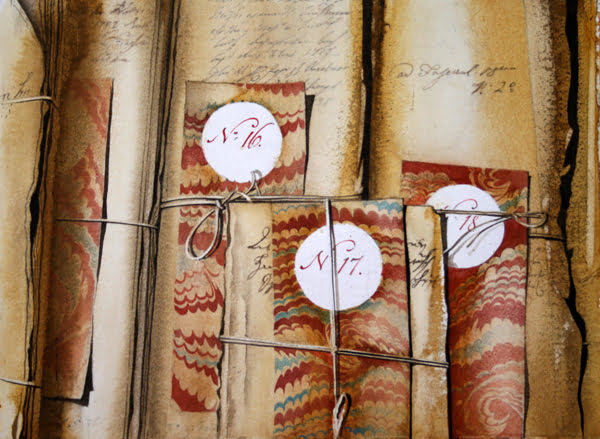The Esterhazy Archive

Summerhall, Edinburgh, 2015
REVIEWS

A LIFETIME’S PAPERWORK
Hugh Buchanan revitalises mundane, everyday records.
Despite the fact this is just the third summer it has been open for business there is a persistent buzz in the ether around Summerhall. A vast collage of creative endeavour on the site of the former Royal (Dick) School of Veterinary Studies, the Edinburgh venue describes itself as a “cross-cultural village” where arts and sciences talk to each other.
When I visited last week, there was a welter of hammering, bashing and work going on as the backroom team get ready for Summerhall’s third Edinburgh Festival Fringe.
I was there to view a new exhibition by celebrated Scottish watercolourist Hugh Buchanan whose work is collected by a host of high heid yins and elevated organisations, including the queen, the Victoria and Albert museum, the Palace of Westminster and the House of Lords.
This is the Edinburgh born artist’s first exhibition in Scotland for 20 years and it has been worth the wait. There are 10 of his paintings in the Dean’s Room, while on the nearby staircase, a grand setting leading to the Richard Demarco Archive, there are six works.
My first reaction on seeing the smaller paintings in the Dean’s Room, shuttered off from strong daylight and the busy street outside was a sense of relief. For the last month or so, I have been looking at big exhibitions in the form of degree shows and the vast RSA annual exhibition, where the competing energy pumped out is dizzying in the extreme. If I needed a darkened room to lie down in, I had found it. To be able to really look at the work of one artist doing quietly contemplative and technically brilliant watercolour painting was a pleasure.
The Esterhazy Archive Watercolours series builds on Buchanan’s ongoing interest in historic archives. The Esterhazy Palace in Eisenstadt, Austria, was once the court of the Princes Esterhazy. A stunning baroque building, it is chiefly known for its associations with the composer Joseph Hadyn, who was Kapellmeister there for almost 30 years at the tail end of the 18th century.
Perhaps less well known is the Esterhazy archive stored at Forchtenstein Castle, south of Vienna. Another Esterhazy stronghold, for the past 500 years the family archive has filled 25 vaulted rooms in the basement of this ancient fortress.
When he visited the archive Buchanan says he was struck by the contrast between the exquisite marbling and calligraphy on these tattered papers and what they contained.
“The efforts of the clerks and archivists to turn the most mundane records of rental agreements and receipts into objects of beauty was hugely impressive” he explains. ” In this series of paintings, I’ve stretched the possibilities of the watercolour medium to evoke the qualities of the torn, brittle, marbled paper, greasy parchment and string. This involved using a variety of techniques, such as sandpaper, to recreate the fragility of these historic documents.”
The paintings have names such as Torn packets at Forchtenstein and Marbled Packets at Forchtenstein, or my favourite, Packets Nos 16,17 & 18 Forchtenstein. In giving them pedestrian names, to echo the contents but not the appearance given to them by those long forgotten creative clerks, Buchanan has made a quiet statement about judging a book by its cover. These are still lives which invite you inside, making you curious not just about the contents, the lists in these centuries-old ledgers, but also the people who took the time to make the documentation so presentable.
Buchanan’s presentation is exquisite. Seldom do you see such clarity and precision in watercolour, which can be the most unforgiving of mediums. The way he renders detail – the tautness of the ancient string and delicate calligraphy – is breathtaking.
Like a finely tuned piece of music, Buchanan plays with light too, and shadows have a starring role. I left Summerhall with a few lines of TS Eliot’s poem The Hollow Men in my head:
“Between the conception
And the creation
Between the emotion
And the response
Falls the Shadow
Life is very long”
JAN PATIENCE, THE HERALD, June 2013
BRITISH WATERCOLOUR PAINTER EXPLORES HUNGARIAN NOBILITY’S ARCHIVES
The title of this new show of 16 watercolours hung all too appropriately in Summerhall’s wood-panelled Dean’s Room, sounds as though it’s been lifted from a 1960s Cold War spy caper. But its depictions of books and documents all bundled up with brown paper and string are even more intriguing. The Esterhazy family archive is stored in Forchtenstein, south of Vienna, in 25 vaulted rooms within the basement of an ancient fortress. Buchanan’s excavation not only captures the meticulous intricacy of the endeavour, but seems to also tap into that very in-vogue notion of archiving as art.
Yet, by observing it at first remove, as Buchanan does here, there’s a gimlet-eyed objectivity to his studies as much as there is warmth. While there are hints of Beuysian-styled detritus on show acknowledged in the title of one of the larger works hung on the walls beside Summerhall’s staircase, framing the archives in impressionistic paintings like this makes them less austere and self-consciously mysterious. The light and shade in each painting bathes the bundles in a romantic glow that gives each package a mythological air to savour.
NEIL COOPER, THE LIST, Aug 2013









